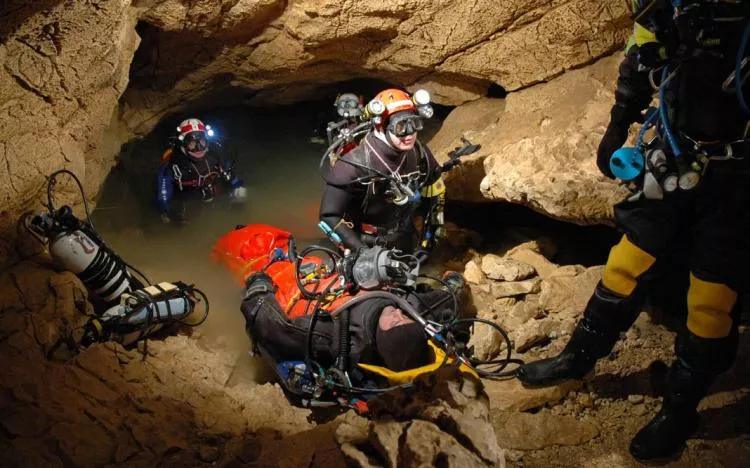That’s it! We managed to take a stretcher to a depth of 54 meters and a total distance of more than 450 meters. What a human and technical achievement!
Contributed by
At the same time, we had to observe the rules set forth by the Spéléo Secours Français—the French Cave Diving Association. We set up a trimix dive, with nitrox decompression and oxygen.
The group Spéléo-Ragaïe was there to shoot a film and brought in hundreds of meters of electric cables, dozens of spotlights and cameras everywhere. The cave seemed to be transformed into a film studio.
Our group was made up of ten divers, and we didn’t have one quiet moment as we had to bring in 70 tanks, of which the biggest was a 50-liter heavyweight and the smallest was a 2-liter tank. Two of our divers use rebreathers.
On Friday night, Frédéric and Jean-Michel Vallon went on a dive and brought back some photographs, so we spent the first part of Saturday studying their images in preparation for the task ahead. Then, we went on the test dive bringing the stretcher down to a depth of 25 meters.
The end of the afternoon was then dedicated to the preparing of all the gear, analysing the gases, planning the stages and decompression stops under the watchful eye of the camera. That day, the outside temperature did not make it above 0° C (32° F), so we enjoyed being inside the relative warmth of the cave.
The next morning, we were joined by Michel Labat and his small team. Their task was to photograph the evacuation as the stretcher exited the sump. We completed the last preparations and suited up.
The conditions were a bit tricky with four divers trampling around in the confined space of the narrow sump. The rebreather divers had to go in while trying to balance the stretcher. Our main concern was whether we had enough space for the stretcher at the bottom. If we inflated it too much, the handling would become very challenging.
We took the stretcher down around noon. I was in the front, Jean-Michel was in the rear, while Olivier Lanet oversaw the management of gases and stops. Frederic handled the camera and acted as the fourth man.
The beginning of the descent went quickly through a small gallery sloping at 45 degrees. Olivier did not have enough space to keep his position through this section, so Jean-Michel had to untie the ropes in his place.
Handling the stretcher was difficult. It was necessary to make stops, as our victim (Michel Ribera, X-RAY MAG co-editor) had trouble equalizing his ears. The gallery then became horizontal for 45 meters. We reached the lowest point at a depth of 46 meters and turned the stretcher around. We kicked up some sediment in the process, but the visibility remained very good, and we ascended to 40 meters to re-position the stretcher.
The final stretch was in a gallery sloping downwards at a 45-degree angle, so we brought the stretcher forward slowly. We made it to 54 meters, and I decided to turn around. After crossing out our checklists, we commenced the ascent two minutes later.
Suddenly, at 50 meters, everything stirred up, and I had no idea of where I was. I had a grip on the stretcher, and I could only hope that my team member had the life line in his hands. Minutes seemed endless while I sat in the middle of that cloud clenching my fists.
Finally, we got out of the fog, and I saw Jean-Michel’s hand grasping the life line. Everything was fine, and the continuation of the ascent was just going to be very physical.
At 30 metres, we reached our first stop and change of tanks. We now breathed 40 percent nitrox after using Trimix 21/37 for the bottom parts. Sebastien Rocheil, Carlos Placido and Thomas Parnet now joined us to assist us during the ascent up to six meters while Olivier oversaw the decompression.
We ascended slowly, three meters at a time. At 24 meters, Olivier joined me and informed me that the computer did not indicate the planned stops. Apparently, some handling error had messed up the computer. I took out my backup tables and joined the stretcher to assist in the ascent.
We connected the oxygen and hoses. Everything went well. Meanwhile, other team members collected the tanks at the bottom and brought them out. The stretcher finally made it up 93 minutes after it went in.
It was a good experince. We achieved our objective, made a deep dive with our stretcher, using different gases, while handling a team member’s rebreather or open system. This simulation also allowed us to test the full face mask, the safety set-up, the dry garment and the team work.
Points to be improved are the balancing of the stretcher in constricted spaces, the location of tanks, the protection of the VR3 against the manipulation band and the communication with the victim during the landings. If everything had gone perfectly, we would have already been at -100m.
But still, we negociated the narrow passages of a 450-meter siphon with a stretcher and took it down to a depth of 54 meters of depth: This is a record! The next exercise will take place in March where we will attempt to carry the stretcher across a sump of 1400 meters. ■
























